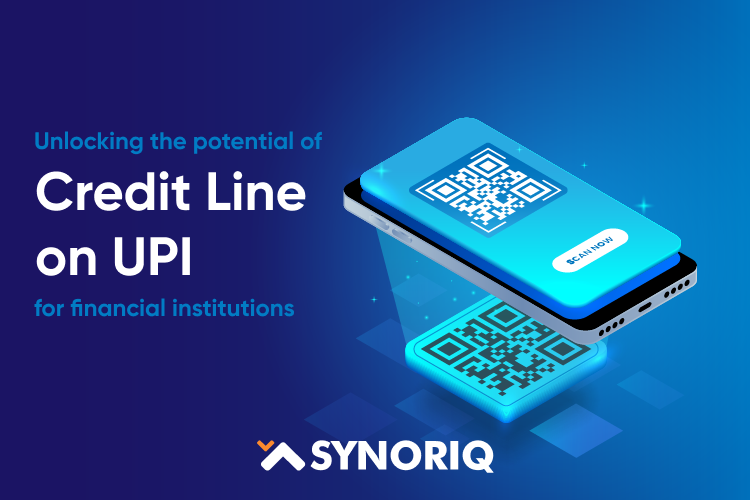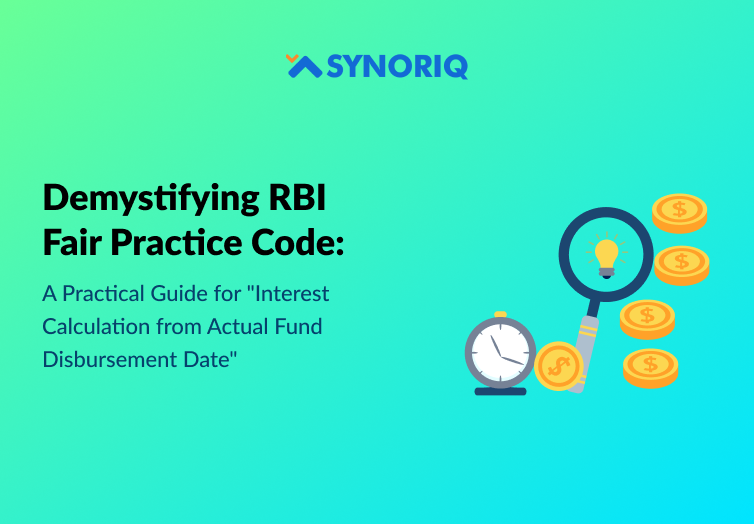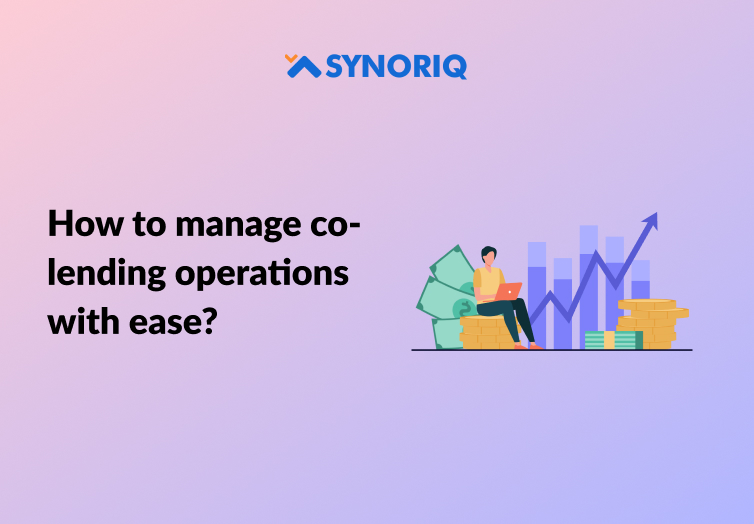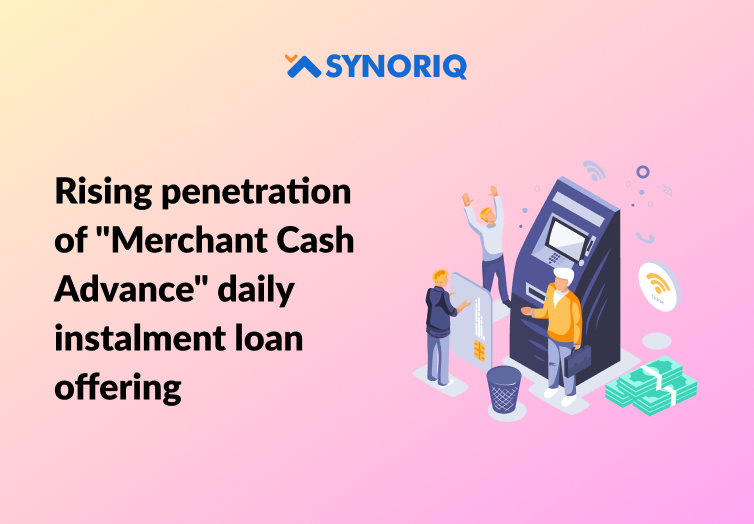Introduction to a financial landscape
In a historic move, the Reserve Bank of India (RBI) announced on September 4th, 2023, the introduction of “Credit Line on UPI.” This groundbreaking concept is set to unleash consumption culture through India’s credit landscape, creating opportunities that were previously untapped. This blog explores the Credit Line on UPI, its impact on users and banks, the banks already embracing it, its vast potential, challenges, and strategies for success. We’ll also delve into how Synoriq’s Loan Management System (LMS) can play a pivotal role in this financial transformation.
What is Credit Line on UPI?
- On September 4th, 2023 RBI released notification to allow Operation of Pre-Sanctioned Credit Lines at Banks through Unified Payments Interface (UPI) . Read it here.
- Under this facility, payments through a pre-sanctioned credit line issued by a Scheduled Commercial Bank to individuals, with prior consent of the individual customer, are enabled for transactions using the UPI System.
- Right now 2 banks are working on this
- ICICI with PayLater offering https://www.icicibank.com/personal-banking/paylater/paylater-faqs
- HDFC Bank with UPI now and pay later offering.

Find the snaps attached ICICI’s offering above*
- If you are existing customer of ICICI bank and you qualify for pre-approved credit line then you would see a popup in net banking and you can sign up for the same and perform KYC and agreement
- Once the bank approves credit line, they would open a separate Overdraft bank account for you with a different account number
- Once you have an active credit line account with the bank, you can go to BHIM application and select Link UPI Credit
Macro view
- Let’s look at numbers – opening up credit line acceptance at UPI QR codes can in-a-way enable 30Cr+ users to use a credit card like product at 3 Cr merchants.
- Number of UPI users: 30 crores
- Number of debit card users: 112 crores
- Number of credit card users: 9.5 crores
- Number of consumer durable loans: 4.1 crores
- Number of UPI merchants – 3 crore
- Number of Credit card terminals – 10 lakh
- Its going to unleash consumption culture – checkout an interesting thesis by Mayank Jain, Stellaris https://www.stellarisvp.com/consumption-unleashed-with-credit-line-on-upi/
Banks in Action
ICICI and HDFC Bank have taken the lead in implementing Credit Line on UPI, offering innovative services that are transforming the way users access credit. Let’s delve into how ICICI Bank’s Pay Later offering works and the key features it offers:
ICICI Bank’s Pay Later: A Seamless Credit Experience If you’re an existing customer of ICICI Bank and qualify for a pre-approved credit line, the process is exceptionally straightforward. Here’s a step-by-step
guide on how it works: 1. Pre-Approved Credit Line: Eligible customers will see a popup notification within their net banking interface, inviting them to sign up for a pre-approved credit line. Upon receiving this offer, customers can initiate the Know Your Customer (KYC) process and agree to the terms and conditions. 2. Overdraft Account: After approval, ICICI Bank opens a separate Overdraft bank account for the customer, complete with a unique account number. This account is specifically designed to facilitate Credit Line on UPI transactions. 3. BHIM Application Integration: With an active credit line account, users can seamlessly integrate it into the BHIM application, a popular UPI platform. The BHIM app will automatically detect the credit line account if it’s active on the user’s phone number, streamlining the setup process. 4. Transaction Initiation: Users can select the credit line account within the BHIM app and commence transactions. Whether it’s paying for goods and services at a merchant or scanning QR codes, the process is user-friendly and efficient. Key Features of ICICI Pay Later Offering: 1. Maximum Credit Limit: ICICI PayLater provides users with a maximum credit limit of Rs 50,000, offering substantial financial flexibility. 2. Credit Period: The credit line comes with a six-month expiry period, allowing users to plan their finances effectively. 3. Instant Digital Credit: Users can access up to 45 days of instant digital credit, providing them with financial flexibility during the grace period. 4. Billing and Grace Period: PayLater generates a bill every month, accompanied by a 15-day grace period for users to settle their dues. 5. Fees and Interest: In case payments are not received within 15 days from the bill generation date, customers will be charged late interest on the daily total outstanding amount. This interest accrues from the bill’s due date. Additionally, a fixed late payment charge is levied on subsequently generated bills until dues are cleared. The penal interest rate stands at 42.8% per annum, plus Goods and Services Tax (GST).
ICICI’s PayLater offering is designed to provide users with a hassle-free and convenient credit experience, offering flexibility, easy access to funds, and competitive features.
Why would anyone use “Credit line on UPI”?
Overdrafts have been rolled out by banks earlier too. But they did not succeed. Will Credit Line on UPI succeed this time?
We believe that due to vast coverage of UPI network, it would be a huge success if Bank’s can innovate on the offering. Below are the advantages for users we see
- Convenience of separate account for petty transactions
- All day-in-life petty transactions through BNPL
- You get crisp Savings Account monthly statements as you divert your smaller spends to PayLater
- Don’t miss a deal even when your saving account is low balance
- Not enough money in my bank account, still to make the purchase. Purchasing before salary day. Check out NPCI video on Credit Line on UPI | For dreams that can’t wait, use Credit Line on UPI!
- Financially aware youngster can use it for credit score building
- NTC users can use it to gradually build credit score
- Convert to EMI offering can be an attractive offering similar to credit card
- Ability to convert to EMIs can make this product popular for consumer loans
- Cheaper credit compared to credit cards
- Cheaper credit available compared to credit cards
- Short term financing use-cases can be fulfilled through credit line too
- Uses cases like Payday loans, Earned wage access and working capital
- A small shopkeeper with a pre-approved credit line can use it to buy products through UPI and pay it back after he sells the goods
- Better security – don’t expose your high value saving account and credit cards
- It provides the convenience of easy checkouts. It helps you protect your Savings Accounts and Credit Card details as you don’t have to input them for making small ticket purchases.
- Better earnings – enjoy interest free credit for 45 days
- PayLater provides an interest free credit up to 45 days, which helps you manage your routine expenses without using your Savings Account balance. Hence, it helps you maintain a higher balance and earn more interest.
Is it not just a credit card? whats the difference?
- No network providers and MDR in credit lines
- Merchants accepting credit cards need to necessarily pay MDR (Merchant Discounting Rate) which is distributed amongst
- Issuer bank – the credit card issuer to the user
- Acquirer bank – the POS terminal provider to the merchant
- Network providers – Visa / Mastercard / Maestro / Diners / Rupay
- This results in 2% deduction for the merchants of which a major chunk is charged by network providers.
- With credit line on UPI, the role of network providers is sidelined. Our very own government UPI stack becomes the network. Hence the transaction costs significantly reduce which is better for the merchants.
- With credit line on UPI, MDR is not applicable as of now. This should increase merchant acceptance.
- Merchants accepting credit cards need to necessarily pay MDR (Merchant Discounting Rate) which is distributed amongst
- 30X better acceptance due to wide UPI accepting merchant base
- You don’t need POS machines for tapping the card. Simply scan the QR code and pay to the merchant.
- Hence credit line will have 30X higher acceptance compared to credit cards
- Credit card like offering with minor tweaks to suit your target market
- Credit line offerings can be slightly different from credit card. For e.g. in ICICI PayLater product
- There is no minimum amount due concept. Fully amount needs to be repaid
- The interest in case of missing the payment starts from the bill due date and not from the transaction date. This is advantageous for the users
- Rewards are limited right now
- Interest rates are lower
- Credit line offerings can be slightly different from credit card. For e.g. in ICICI PayLater product
- Credit lines offer far lower barrier to entry for banks compared to credit cards
- Only a handful of banks offer credit cards (approx 10 of 40+ scheduled commercial banks)
- There is a high barrier to entry due to Capex costs involved in setting up credit card technology and operations stack
- With “credit line on UPI” – the Capex costs significantly reduce
- Credit line can be a product for mass market with possibility of 10X deeper penetration
- Credit cards are not viable for the banks for mass market due to high customer acquisition costs (nearly INR 5K per user). Hence
- With credit line, due to low onboarding costs – banks can offer limits as low as INR 1000 and target mass market of BNPL
Why should banks offer credit line offering when there is no MDR?
- Expand credit customer base with low CAC
- CAC (Customer Acquisition Costs) for any credit products for the bank – average CAC for credit card customer is Rs 5000. With credit line offering, banks can acquire customers at much lower costs
- Offering sachet credit (less than Rs 10K) to NTC (New To Credit Banks) can result in good credit worthy customer base for future upsell
- Upsell and improve revenues
- Upsell credit cards, personal loans and all other loan products based on behaviour pattern in sachet credits
- Credit lines can itself be a profitable business line
- Generate moderate revenues through interest income – Focus on interest income generated through credit line and explore fee income opportunities over time. If 60% of customers can start paying interest, it can be a good business on its own.
- Keep costs ultra low by using technology – Credit lines can be operated with minimal OPEX and CAPEX – simply focus on automation through digital onboarding, transactions and collections
Suggested Strategy for Banks
Banks venturing into the Credit Line on UPI landscape need a well-thought-out strategy to make the most of this innovative offering. Here’s a comprehensive plan to guide their approach:
- Create a Compelling Product Proposition: Design a product that resonates with consumers, incorporating elements familiar from credit card experiences.
- Introduce Minimum Amount Due: Similar to credit cards, offering a minimum amount due can make the product more attractive and user-friendly.
- Flexible EMI Options: Provide users the choice to convert transactions into EMIs, both on a transaction basis and for monthly billed amounts.
- Reward Programs: Implement attractive reward schemes to enhance the product’s appeal.
- Self-Limit Enhancements: Enable users to enhance their credit limits based on their financial behavior and preferences.
- Asset-Backed Comfort: Offer higher credit limits with assets like Fixed Deposits (FDs), Mutual Funds, Shares, and Gold as collateral.
- Aggressive Customer Acquisition: Roll out credit lines to a wide range of customers, possibly even with small limits, to reach a broad user base.
- Expand Interest-Paying Customers: Focus on increasing interest-paying customers to maximize revenue, as Fee Income (such as Processing Fees and Penalties) may initially contribute less.
- Effective Product Math: Optimize the product’s mathematical structure, with a balance of interest rates, fees, and user-friendly features.
- Risk Minimization:
- Implement measures to identify optimal billing dates based on cash flow cycles.
- Develop robust fraud risk management systems.
- Actively monitor and control merchant codes to prevent fraudulent usage.
- Utilize Dropline functionality to reduce risks by ensuring regular payments.
- Operational Efficiency:
- Streamline operations by going fully digital, reducing operational expenses (OPEX) related to onboarding, utilization, and collections.
- Use a dedicated Loan Management System (LMS) to minimize OPEX compared to traditional Credit Card Management Systems (CCMS).
- Cross-Sell Opportunities:
- Explore cross-selling personal loans, credit cards, and other banking products to Credit Line on UPI customers.
- Lobby for Fee Income and MDRs:
- Advocate for measures that enhance fee income and explore possibilities for Merchant Discounting Rates (MDR) in the ecosystem.
- Investigate subvention and no-cost EMI models through merchant partnerships for additional income.
Below is an illustration of Potential flow of onboarding-

and potential transaction flow from credit line on UPI

This comprehensive strategy equips banks to navigate the Credit Line on UPI landscape effectively, providing users with accessible and user-friendly credit services while maximizing the banks’ revenue potential.
In summary, Credit Line on UPI provides a simplified and cost-effective solution for banks to offer credit services, expanding their customer base and making credit accessible to a broader audience, including those new to credit. This innovation is poised to transform the banking landscape by making credit more inclusive and efficient.
Potential threat to credit line could be lack of fee income
As promising as the Credit Line on UPI is, it does come with its fair share of challenges that need to be addressed for its widespread adoption and success.
1. MDR Mechanism Absence: One significant challenge is the absence of a Merchant Discounting Rate (MDR) mechanism within the Credit Line on UPI system. The revenue composition for banks and financial institutions may shift due to the introduction of the Credit Line on UPI. For instance, SBI Cards currently derives approximately 52% of its revenue from fee and commission income and only 48% from interest income. The Credit Line on UPI could impact this revenue mix.
2. Unclear subvention mechanism to enable Zero-Cost EMIs: Enabling zero-cost Equated Monthly Instalments (EMIs) is an intriguing prospect, but it relies on subvention partnerships with brands and merchants. How this will technically work remains an open question. This feature, while appealing to users, presents a hurdle in implementation.
Addressing these challenges and understanding the potential risks is vital in the journey to make Credit Line on UPI a sustainable and beneficial addition to India’s financial landscape.
However, a few pertinent questions arises and those are:
Can the Credit Line on UPI Replace Credit Cards?
– High reward credit cards are likely to coexist alongside the Credit Line on UPI.
– Absence of Merchant Discounting Rate (MDR) may limit competition with high-reward credit cards.
– Potential for gradual replacement of low reward credit cards with Credit Line on UPI.
– Designed for the mass market, aiming to bring millions of New to Credit (NTC) customers into the credit ecosystem.
Is UPI Zero-Cost EMI a Possibility?
– Exploring zero-cost Equated Monthly Installments (EMIs) on UPI is promising.
– Requires subvention partnerships with brands and merchants.
– Involves a mechanism similar to credit cards, with merchants and banks sharing Bank Identification Codes (BIC).
– Settlement for subvention would occur outside the system, akin to credit cards.
– Technical details of implementing zero-cost EMIs on UPI remain an open question, requiring further exploration.
How Synoriq’s LMS Facilitates Credit Line on UPI for Banks?
Synoriq’s Loan Management System (LMS) plays a pivotal role in helping banks implement and manage Credit Line on UPI offerings efficiently. Here’s a closer look at the valuable features and capabilities that Synoriq’s LMS brings to the table:

Visit Synoriq.com to dive deeper in the features**
1. Configurability for Innovative Loan Products:
– Synoriq’s LMS offers a high degree of configurability, enabling banks to create innovative loan products tailored to their specific requirements.
2. Limit Management:
– The LMS includes robust limit management features, allowing for:
– Automated limit enhancement with customer consent.
– On-demand limit increase or reduction.
– Provision for ad-hoc limit adjustments during festive seasons.
3. Expiry and Renewal Management:
– The system automates the management of credit line expirations, sending alerts and facilitating seamless renewal flows.
4. Billing Flexibility:
– Synoriq’s LMS offers extensive flexibility in billing options:
– Users can enjoy interest-free periods and grace periods.
– Customized statement generation dates based on individual cash flow patterns.
– Multiple billing cycle options, including daily, weekly, bi-weekly, monthly, and quarterly.
5. Repayment Configurations:
– The LMS provides various repayment options, including:
– Dropline structures where the limit gradually decreases after an initial period of full availability.
– Minimum amount due configurations, mimicking credit card-like behavior.
– Convenient conversion to EMI for single transactions or entire bill amounts.
6. Fees and Penalties:
– Banks can configure and manage a range of fees and penalties, including:
– Processing fees.
– Annual fees.
– Penal charges.
– Penal interests.
7. Collateral-Backed Credit Cards:
– The system supports collateral-backed credit cards, enabling banks to offer secure credit lines:
– Collateral options include cash collateral (savings account/FD), gold, and more.
– Flexibility to allow or disallow early payments.
8. Customized Billing and Limits:
– Clients can use customized billing dates based on user-specific cash flow patterns.
– Provides flexibility in setting maximum carry forward limits.
– Implements auto reminders to ensure timely payments and enhance user experience.
Synoriq’s LMS empowers banks to offer and manage Credit Line on UPI products efficiently, providing a seamless and flexible user experience while maximizing banks’ revenue potential. The configurability and comprehensive feature set make it an ideal platform to navigate the evolving landscape of digital finance.
Want to know more about our LMS? We are thrilled to show you around.
Drop an email on growth@synoriq.in
Frequently Asked Questions (FAQ’s)
- What is Synoriq’s LMS, and how can it benefit our financial institution?Synoriq’s LMS is a scalable loan management solution designed to enhance efficiency, introduce new loan products quickly, and ensure regulatory compliance for your financial institution.
- Is Synoriq’s LMS customisable to meet the specific needs of our institution?Synoriq’s LMS is incredibly configurable. You can configure repayment schedules, charges (including nature, stage, and state etc), amortisation, chart of accounts, policies, asset classification, just to name a few. The repayment schedule configurations offer precise control, including principal and interest frequency options. Plus, it allows you to create and deploy new loan products and schemes in just 20 minutes. This flexibility ensures your institution’s lending solutions can align perfectly with your specific needs, enhancing efficiency and compliance.
- Can Synoriq’s LMS integrate with our existing banking systems and processes?Synoriq’s LMS is designed to be seamlessly integrated with your existing banking systems and processes. It’s API-based and offers the flexibility needed to adapt to your specific requirements, ensuring a smooth and efficient integration experience. We’re also committed to working with you to create a tailored solution that fits your needs.
- Is Synoriq’s LMS compliant with regulatory requirements and standards in the financial industry?Synoriq’s LMS always strives to stay ahead in ensuring compliance with regulatory requirements and industry standards, providing your institution with confidence in its compliance.
- Do you provide training and support for our staff when implementing the LMS?We offer comprehensive training and support to ensure a smooth implementation of our LMS for your staff.
- What is the implementation process like for Synoriq’s LMS, and how long does it typically take to go live with the solution?The implementation process typically spans 3 to 8 weeks, tailored to your specific needs. We are also migration experts, assisting with the seamless transfer of your existing data onto our system.
- What is the ongoing support and maintenance offered once our financial institution has adopted Synoriq’s LMS?We provide ongoing support and maintenance to ensure your institution’s smooth operation. Your success is our priority.
- Can we request a demo or speak with a Synoriq representative to discuss our specific requirements?Certainly, we are eager to provide a comprehensive demonstration of our LMS and discuss how it can cater to your specific needs. To request a demo or speak with a Synoriq representative, you can click here or reach out to us at growth@synoriq.in. We’re here to assist you promptly.




Leave A Comment